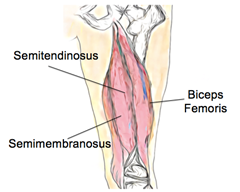Physio Health Advice > September Newsletter!
Focus On Hamstring Tears

What are they?
The hamstrings are a large group of muscles, located at the back of the thigh. Their job is to bend the knee, move the hip backwards and stabilise the leg. The muscles can be injured at any point but are most vulnerable where the tendon and muscle fibres join together. This is a common injury for players of all sports that involve running, but particularly those that involve quick movements and kicking.
What are the causes?
As the hamstrings cross two large joints, they need to perform complicated movements, often activating suddenly and with great force. They are often stretched during a fall, large kick or sudden take-off. Factors that increase the chance of a tear, include poor flexibility and neural mobility. Other factors that contribute to hamstring injuries are muscle imbalances, abnormal lower limb biomechanics, fatigue, and inadequate warm-up. It seems, however, the biggest predictor of a future hamstring tear is a previous hamstring injury.
What are the symptoms?
The most common symptom of a torn hamstring is a sharp pain at the back of the thigh, often immediately after intense activity. There may also be swelling, bruising, difficulty walking and pain with knee movements. The symptoms of a hamstring tear are similar to many other conditions, as the lower back often refers pain to the back of the thigh, mimicking a hamstring tear.
Your physiotherapist can confirm that the pain is due to a torn hamstring and tell you how bad the tear is. Although not usually required, diagnosis can be confirmed by having an MRI or real-time ultrasound scan.
How can physiotherapy help?
Once a diagnosis has been made, the first step is to follow the R.I.C.E protocol (Rest, Ice, Compression, Elevation). During the first 48 hours, you should apply ice for 20 minutes every hour to reduce swelling and bruising. Consultation with your physio will include advice about your recovery, and when it is appropriate to return to sport. Your physiotherapist has many techniques that can promote healing and reduce scar tissue formation, which may include ultrasound, deep tissue therapy, laser, TENS and dry needling.
They will also prescribe an exercise program to return strength, flexibility and control to the muscle, getting you back to your sport quickly and safely. Due to the high chance of recurrence, rehabilitation is very important and usually takes 6-12 weeks. If the muscle is completely torn, surgery may be required before rehabilitation can start. Your physiotherapist will work with you to help you set goals to get you back to your favourite activities as soon as possible.
None of the information in this article is a replacement for proper medical advice. Always see a medical professional for advice on your individual injury.
Making The Most of Your Physio Treatment
Seeing a physiotherapist is an important investment in healing and recovery from injury. Here are a few tips to help get the best outcomes from your treatment time.
Know what your goals are and ask questions.
If you are clear on what you hope to achieve through physiotherapy, this can help you and your therapist to work together to target treatment towards these goals.
Understanding your condition also plays an important part in recovery, it means that you can make better choices to protect and allow your body to heal, plus you will know better how to prevent future injuries. Before each treatment, it can help to take a few moments to prepare some questions and consider what your short and long-term goals might be.
Do your exercises.
Targeted home exercises are an essential part of your recovery as they help your body to support itself through healing and recovery. Strengthening weak muscles is one way to correct biomechanical imbalances and reduce excess stress on body structures, as well as helping tissues to strengthen as they recover.
Follow your therapist’s recommendations.
Throughout your recovery, your therapist will guide you as to which activities you should avoid and how much rest to take. Return to sport and activity should be gradual, so as not to stress the body too hard when it is still healing.
Rest is just as important a part of recovery as strengthening. Following the advice given by your therapist can ensure that you don’t injure yourself again and get the most out of your body.
Be patient with your progress.
It can be frustrating waiting for your body to heal. Returning to sport too early or giving up on treatment are common errors that lead to further injury or impaired healing. Recovery takes time, a general rule is that the longer a condition has been present, the longer it will take to resolve.
If there is a part of your condition or injury that you are struggling to understand, be sure to seek clarification with your physiotherapist. None of the information in this article is a replacement for proper medical advice. Always see a medical professional for advice on your condition.
Sweet Potato & Carrot Cake

Ingredients:
2 cups Plain Flour
1 tsp. Baking Powder
1 cup Sugar
1 Egg
1 Sweet Potato, roasted and mashed
2 Carrots, grated
1 cup Milk
1 tsp. Ground Cinnamon
3 Tbsp. Butter
Icing
1/2 cup Icing Sugar
1 cup Plain Greek Yoghurt, strained
1 tsp. Vanilla Essence
- Preheat oven to 180d ℃ and grease a medium-sized cake tin.
- Combine butter, cinnamon, carrots, sweet potato, eggs, milk, sugar and baking powder in a medium-sized mixing bowl and mix thoroughly.
- Add flour and stir into the mixture until a smooth batter forms.
- Add mixture to cake tin and bake for 35-40 minutes. Use a skewer to check when the centre of the cake is cooked.
- To make the icing, take strained yoghurt, vanilla essence, butter and sugar and mix with an electric hand mixer until the icing is thick and smooth with no lumps. Place in fridge to set while the cake is baking.
Allow to cool, cover with icing and serve when ready.

